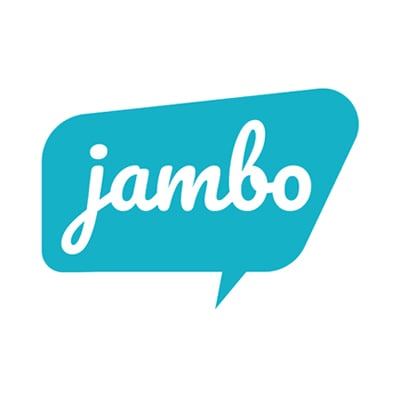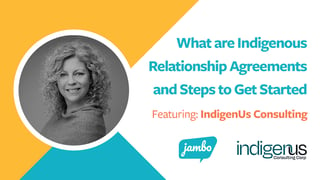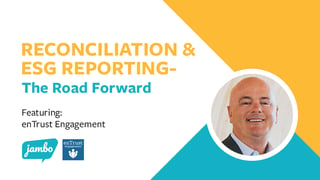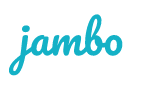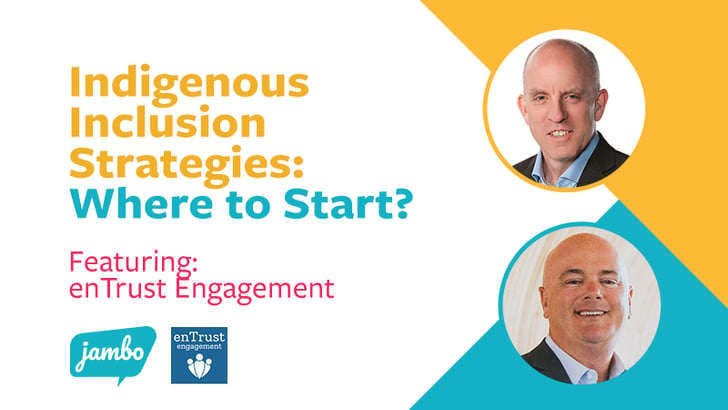
What goes into an Indigenous inclusion strategy and how can effective engagement support these processes?
Joining Jambo for this Q&A blog is Darryl Holloway and Michael Reid, both Principals at enTrust Engagement Inc. (enTrust Engagement). For Darryl and Michael's complete bios, visit their team page.
"enTrust engagement Inc. provides a full spectrum of practical, forward-thinking solutions in the complex and rewarding areas of Indigenous / Tribal relations, stakeholder and community engagement, local and Indigenous / Tribal business development, government relations and overall sustainability performance."
Darryl has over twenty years of experience in banking and corporate finance. Twelve years ago, he became more involved with economic inclusion with Indigenous communities. He recently completed his MBA from Simon Fraser, specializing in Indigenous Business & Leadership.
Michael has been in the Indigenous and stakeholder relations space for over twenty years. He has led Indigenous Relations teams for multi-national energy companies in both Canada and the United States.
We were fortunate to have the opportunity to ask them questions about Indigenous inclusion strategies and how effective engagement can support these processes.
In this blog, we'll cover:
- What Is an Indigenous inclusion strategy?
- Why Is an Indigenous inclusion strategy important?
- How does an Indigenous inclusion strategy differ from a stakeholder engagement plan?
- Some ways to include Indigenous Nations in your engagement plan
- Steps for organizations that are new to Indigenous inclusion strategies
- Who should consider Indigenous cultural awareness training?
- Hiring Indigenous people to work on projects
- Why engagement Is critical when managing relationships with Indigenous Nations
- Options to adequately track Indigenous engagement
- Suggestions for organizations that need help with Indigenous inclusion strategies
Q: What is an Indigenous inclusion strategy?
An Indigenous inclusion strategy can include several important elements. At its core, it’s building a strategy to include Indigenous people and Indigenous Nations into businesses, organizations and initiatives, while ensuring Indigenous individuality and cultural nuances are understood and respected. In the spirit of reconciliation, Indigenous inclusion is an increasingly important consideration for many companies.
These strategies are for corporations and Indigenous Nations
 Indigenous inclusion is important for both Indigenous Nations and companies. enTrust supports the development of capacity within both Nations and companies.
Indigenous inclusion is important for both Indigenous Nations and companies. enTrust supports the development of capacity within both Nations and companies.
This work is for all companies
It’s not just the oil and gas or resource extraction sector, but also banking, the hotel industry, tourism, professional sports teams and other profit and not for profit entities. Many organizations ask, especially through the lens of reconciliation, diversity and inclusion, what role their company can play in including more Indigenous people in their business.
In developing Indigenous inclusion strategies, we work with companies to establish a policy or a guideline on how the company actions the strategy, how they will implement Indigenous-led cultural awareness, developing plans around economic and workforce inclusion and overall community involvement.
When asked and invited by the Nations, we support in determining how to be included in corporations and businesses. Often, we're working on building a bridge for partnerships and agreement negotiations with corporations. At times, we support initiatives such as developing a water authority, addressing food sovereignty, or building a gas station.
Back to the top!
Q: Why is an Indigenous inclusion strategy important?
Accountability
Having a strategy and a plan helps a lot. It's one thing to say that you want to do something, it's another to put energy and effort into strategizing, planning and actioning it.
It’s important that the company clearly understands what it means to have greater Indigenous inclusion, whether it's in contracting or workforce or policies. It’s critical to put a clear process and tools in place to make sure this happens.
We sit with clients who want to do this because they believe it’s a good thing to do, and it’s good for their business. By strategizing and planning, especially with leadership involved, they also understand where the business is going, what their role is, and ultimately, what their accountability is going to be.
Without a plan in place, there is no real accountability, so no one understands what success looks like, and then it doesn’t happen in a meaningful way.
In the conversations we’re having with corporate North America, many people want to personally do something from a reconciliation perspective with Indigenous people. This work allows them, within their work-world, to have a plan, a strategy and a role to play in the reconciliation process.
Define the business drivers

Part of what we do is try to explain how this is good for business. We define the business drivers behind putting these strategies in place to help make it clear to everyone in your organization what their roles are and how it could positively impact the business.
Back to the top!
Q: How does an Indigenous inclusion strategy differ from a stakeholder engagement plan?

Indigenous peoples should never be categorized as stakeholders. They have constitutionally protected rights to be engaged, consulted, and included and, as a result, should not be treated the same as stakeholders.
An Indigenous engagement plan should be created alongside your stakeholder engagement plan, and an Indigenous inclusion strategy can complement and direct your Indigenous engagement plan.
Recognizing and respecting the legal and constitutional rights of Indigenous peoples is of vital importance. Regarding the legal duty to consult, we need to be aware of how decisions can impact Indigenous Nations and ensure we are meeting their expectations by engaging early, transparently, respectfully, and meaningfully—this is where Indigenous awareness training is very important.

An engagement plan can support the strategy work
Some of our clients are suppliers/contractors for the project’s proponent and do not have consultation requirements outside of the proponent’s Indigenous Inclusion policies. Even in the absence of a consultation requirement, where you're tracking and recording engagement for regulatory purposes, you still want to manage your engagement with the Indigenous Nations you're building a relationship with, whether it's from a workforce or contracting perspective.
You still want to have a plan in place on how you're going to go out and engage and also have the ability to track and record that engagement to know your strategy is moving in the direction you intended it to go.
With some of our Indigenous clients, their leadership wants to ensure the Nation’s citizens are fully engaged. Leadership wants to make sure there’s an engagement plan in place and that it’s being acted upon, and it’s all making sense to better ensure that their citizens are fully informed about projects.
Back to the top!
Q: What are some ways to include Indigenous Nations in your engagement plan?
How do Indigenous Nations want to be engaged?

It's critically important to understand how the Indigenous Nations want to be engaged:
- What does that look like?
- What are the Nation's protocols?
- What is the Nation’s approach?
Each Nation is unique, so you need to understand how they want to be engaged and their unique protocol for that engagement. Start there, without any preconceived notions of what it could look like.
Indigenous Nations aren’t all the same

A lot of times, for companies, it's having that conversation to understand the goals and drivers in the Indigenous Nation.
Often, a corporation will go in with a canned program that may have worked in the past that doesn't meet the expectations of the Nation they are currently engaging with.
What companies must understand is that Indigenous Nations aren't the same, though while each Nation is unique, the principles of respectful and meaningful engagement apply. They might have different cultural practices, goals, and drivers, so trying to fit your engagement into a box doesn't work.
Go in, ask lots of questions, be open-minded and be willing to work with the Nation—follow their lead.
Back to the top!
Q: What are the first steps for organizations that are new to Indigenous inclusion strategies?
Leadership from a company need to be involved early

Like I mentioned earlier, having leadership involved early is key.
It’s important to earn respect and support from Leadership in order to receive guidance and advice as you continue to move along--Especially leadership from those key areas, whether it’s human resources, or supply chain management, or some of the core groups that will have a role to play in the inclusion strategy being implemented.
Internal communication is key
For organizations and corporations, leadership needs to communicate internally very early about the company's desire to go down this road:
- Why is the company doing it?
- What's the purpose?
- As they begin implementing it, what does it mean?
- What's your role going to look like?
- How's it going to look?
- What does success potentially look like?
It's the employees that will have a role within it, so they need to have a clear understanding of what their role could be and what their accountability might be.

I can't stress enough that communication from leadership is vital. It's one thing to say, "We support this," and why, but being very purposeful in working with Indigenous Nations and having leadership meetings Chief to Chief is essential.
Mike and I have been involved in a lot of meetings where the CEO, President or Senior Vice President have stepped out and into that role to have those direct conversations. Not only do they get a lot out of it, but it sends a powerful message throughout the company as well.
Back to the top!
Q: Who should consider Indigenous cultural awareness training, and why is it so important?

Our philosophy is that everyone within an organization should have some level of Indigenous cultural awareness training, and those who are going to be working with Indigenous communities a lot will need more in-depth training. We also believe that this training should be Indigenous-led and preferably from the perspective of the local Indigenous Nation.
As part of reconciliation, the more Canadians that understand Indigenous culture and Indigenous people, the better Canada is, and the better a company is.

Back to the Top!
Q: If I want to hire Indigenous People to work on my project, how do I start this conversation?
What nations are within this space?

You need to understand where you're operating and then learn about and understand the different Nations within that area and their key drivers. The key to understanding is the development of strong relationships, engage early and often.
Define the need and find the link

Like Darryl is saying, understanding what the Nation wants to do from a workforce perspective is vital.
You may go in with a certain workforce activity in mind, and that activity might be of no interest to most of the Nation. Still, there may be elements of training or something that your company can do to aid or enhance what Nation members want to do from a workforce perspective.
Listen to the Nation and understand where they are and then consider the demand your corporation has in terms of workforce and capacity needs. If there's a link, plan and strategize around that need.
Cultural nuances

Many corporations don't understand some of the cultural nuances in Nations around work.
For example:
- What happens if there is a death in the community?
- What happens when the hunting season opens?
- What unique barriers to successful employment might an Indigenous person encounter?
- How do we accommodate important cultural events?
You need to be prepared to discuss those cultural nuances, so you can prepare your workforce to respond adequately.
Back to the top!
Q: Why is engagement critical when tracking relationships with Indigenous Nations?
Are we moving in the right direction?

You can put your strategies and plan in place, but with tracking and engagement, whether they're conversations around workforce or contracting, that allows you to know if you're moving in the right direction and for the Nation to see if you're moving in the right direction.
We’ve also worked on projects for Nations and heard from leadership that they want to ensure engagement with Nations citizens is well tracked. Leadership wants their citizens providing input on projects such as establishing water authorities, developing food sovereignty solutions and building infrastructure.
Where did you leave off last time?
We hear from clients who have numerous groups within a company engaging with a Nation at different times. Engagement tracking helps if you're going in as, for example, the HR person, you'll have the ability to pull up the engagement history to see what's been discussed already, so you're updated, and everyone knows where the relationship is at—it helps with accountability.
Avoid engagement fatigue

Sometimes organizations are very eager to get out and talk. As Michael said, you have many different people engaging with a Nation and a lot of times, you're all engaging with the same people within that Nation. It can be very wearing on the individual...
For example, as a major oil company, you might not be the only one engaging in that area. If the Nation is talking to ten different people from ten different companies, that's one hundred conversations they're having!
Tracking can help manage that overload within a corporation. When tracking, you can say, "we've attempted to reach out to the Chief ten times this month, and they took our call the first two times and stopped," and it might be because they don't want to talk to you anymore. After all, they’ve got ten other companies and a Nation to run. This tracking gives you a better sense of what’s going on.
Back to the top!
Q: What are some options to adequately track Indigenous relationships and engagement?

A software solution can help you to effectively manage Indigenous relationships and engagement. Whatever software you choose, it needs to be:
- Easy to use; otherwise, people won't use it
- Accessible
- Intuitive
- Able to record conversations right after meetings take place
Avoid messy engagement tracking methods
The unfortunate thing is, so many people are using basic spreadsheets or other software systems not made for engagement, and they just don't work. While these basic methods are better than nothing, they’re not appealing or user-friendly, so they don't get used consistently - and consistency is key.
The worst part is you’ll only realize these spreadsheets and systems aren’t the best options when your scrambling to search through and compile a report on all your engagement data because you’ve been asked to appear at a legal hearing or a regulatory body is requiring it from you.

Also, with spreadsheets, not everyone has access to them, and they don't get updated promptly, so a software system that is accessible, searchable, intuitive and easy to use is essential.
That's one of the reasons we connected with Jambo. We’ve used a range of different software systems at our various workplaces but found that Jambo meets these needs and is what we’d promote for our clients use.
Back to the Top!
Q: What would you suggest for organizations that can't do this themselves?

We'd suggest they give us a call. Darryl and I offer a lot of experience. We understand the business drivers to a great degree, but we also come to this from a practical perspective, and we're not going to waste people's time and money. We'll leverage the experience we have and find results.
We're hearing from our clients now, especially our energy clients where budgets are very tight and dollars and cents matter--we offer an alternative to going out and hiring a full-time employee. With us, you get a depth of experience for a reasonable cost that's practical and solutions oriented.
We bring significant capacity in the Indigenous inclusion space for corporations and Nations.
enTrust’s services:
- Community capacity support
- CSR/social performance risk materiality
- Engagement & consultation planning
- Government relations
- Local content strategy development
- Policy development
- ESG & social impact
- Research & report writing
- Training & workforce development/implementation
Visit the enTrust services page for more information.
Next steps
If you’d like to learn more about the enTrust Engagement team and the services they offer, visit their website for more details or contact the team.
Thank you to Michael and Darryl and the rest of the enTrust team for speaking with Jambo for this blog post!
Back to the top!



